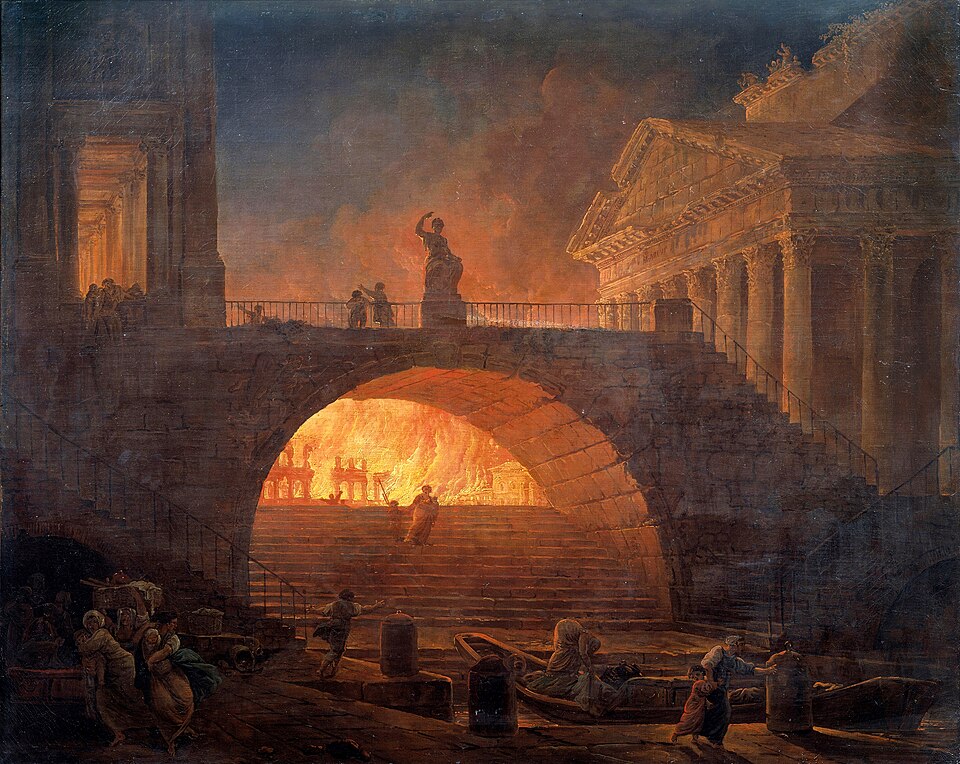
What was the Great Fire of Rome? The Great Fire of Rome was a huge fire that decimated the city of Rome in 64 AD. It is the fire that burned Rome while Emperor Nero was supposed to have been playing his fiddle.
Most major cities that have a long history will have had a “great” fire at some point. In fact, I would venture that all large cities have been burnt down more than once. The Great Fire of London, for example, is well known, but it is only one of at least 17 large fires that hugely damaged the city. Fires were an unfortunately natural part of a city, just as they are for a forest. Houses were made almost entirely of wood. There were sometimes brick or concrete structures, but the majority of the people lived in cheap wooden housing. Houses were also built close together and, as there were no real land planning laws, wherever people wanted. Houses sometimes even leaned into each other for support. There was no trash removal system, and flammable material would have built up in the streets. Then, as there was no electricity, fire was a way of life. People cooked with fire, heated their houses with fire, and lit their houses at night with fire. The fact that fires weren’t even more common is the mystery. Then, on top of that, there were no fire fighting services. If there were a fire, locals would attempt to put it out, but they could never be very effective. The watchmen and the army would help if the fire was too big, but often the only way was to pull down houses to make a fire break and to wait for the fire to exhaust itself.
Rome was no exception to this, and by the time of the Great Fire in 64 AD, Rome had had several major fires. In fact, the richest Roman of all time, Marcus Licinius Crassus, made a lot of money by owning his own private fire brigade of 500 men. Whenever there was a fire, the fire brigade would rush to the location and offer to buy burning buildings at a ridiculously low price. If the owners agreed, Crassus’s fire brigade put out the fire. If they didn’t agree, the fire brigade let the building burn down. Crassus also bought up burned down buildings. He died 11 years before the Great Fire of Rome.
The Great Fire of Rome broke out on July 19th, 64 AD. It started in the shopping district near to the Circus Maximus, a chariot stadium. The shops and houses in this area were made of wood, very close together, and there were piles of merchandise lying around. Unlike the Great Fire of London, where we know the exact starting point of the fire, there are no accurate records for the start of the Great Fire of Rome. There is only one eye-witness account of the event, written by a historian called Tacitus. The only other accounts, which are the ones that lay all the blame at the feet of Emperor Nero, was written by a historian called Suetone, who was born 4 years after the fire, and Cassius Dio, who was born 90 years after the fire.
It was a hot summer, and everything was dry. The fire spread rapidly and was pushed north by the wind. The winds were strong that day, but fires are also able to create their own wind, causing fire tornadoes. The fire in Rome burned for six days before it went out. However, this was just a lull, and the fire restarted, burning for another 3 days. By the end, it had destroyed 10 of Rome’s 14 districts. There are no official records of how many died, but it was said to be hundreds, and thousands were left homeless.
Three things came out of this fire. The first was the reputation of Nero. During the fire, rumors abounded that he had started the fire for his own personal gain and because he wanted to make a new palace for himself and to remake the city. There were rumors that he dressed in theatrical clothes and played his lyre (which became a fiddle in modern times). These rumors existed at the time, but they were embellished by the two historians who were born after the fire. Tacitus does mention them, but he doesn’t say if they are true or not. What he does say is that Nero returned to the city when he heard of the fire. He used his people to pull down buildings to make fire breaks, which could have been where the rumor that he started the fire came from. He opened up private spaces and his own gardens for the homeless people to stay in. He shipped in grain from nearby places to feed people. The second thing was the rebuilding of Rome. Nero introduced rules to make fires less likely, and some parts of his city design can still be seen. Although he did build the new palace that people were talking about. He built the palace on land he already owned, so it was not a motive for him to start the fire. And the third thing was that the marshes around the city were filled in with debris from the fire to be built on. These marshes were infested with malaria carrying mosquitoes, and this action drastically cut down on the amount of malaria in Rome. And this is what I learned today.
Sources
https://origins.osu.edu/read/great-fire-rome
https://en.wikipedia.org/wiki/Great_Fire_of_Rome
https://en.wikipedia.org/wiki/Cassius_Dio
https://www.history.com/this-day-in-history/july-19/neros-rome-burns
https://en.wikipedia.org/wiki/Early_fires_of_London
https://en.wikipedia.org/wiki/Marcus_Licinius_Crassus
http://www.eyewitnesstohistory.com/rome.htm
https://origins.osu.edu/read/great-fire-rome
Image By Hubert Robert – http://www.kunst-fuer-alle.de/index.php?mid=77&lid=1&blink=76&stext=caesar&cmstitle=Bilder,-Kunstdrucke,-Poster:-Caesar&start=80, Public Domain, https://commons.wikimedia.org/w/index.php?curid=6606073
